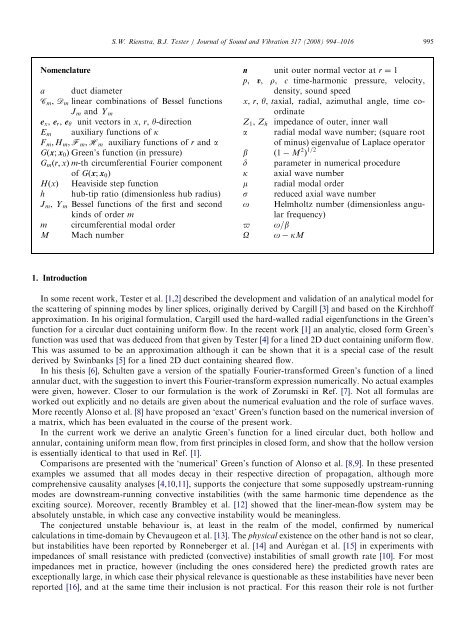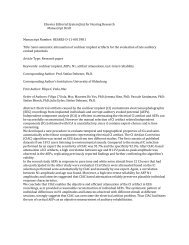An analytic Green's function for a lined circular duct containing ...
An analytic Green's function for a lined circular duct containing ...
An analytic Green's function for a lined circular duct containing ...
Create successful ePaper yourself
Turn your PDF publications into a flip-book with our unique Google optimized e-Paper software.
Nomenclature<br />
a <strong>duct</strong> diameter<br />
Cm, Dm linear combinations of Bessel <strong>function</strong>s<br />
Jm and Y m<br />
ex, er, ey unit vectors in x, r, y-direction<br />
Em<br />
1. Intro<strong>duct</strong>ion<br />
ARTICLE IN PRESS<br />
S.W. Rienstra, B.J. Tester / Journal of Sound and Vibration 317 (2008) 994–1016 995<br />
auxiliary <strong>function</strong>s of k<br />
F m; Hm; Fm; Hm auxiliary <strong>function</strong>s of r and a<br />
Gðx; x0Þ Green’s <strong>function</strong> (in pressure)<br />
Gmðr; xÞ m-th circumferential Fourier component<br />
of Gðx; x0Þ<br />
HðxÞ Heaviside step <strong>function</strong><br />
h hub-tip ratio (dimensionless hub radius)<br />
Jm, Y m Bessel <strong>function</strong>s of the first and second<br />
kinds of order m<br />
m circumferential modal order<br />
M Mach number<br />
n unit outer normal vector at r ¼ 1<br />
p, v, r, c time-harmonic pressure, velocity,<br />
density, sound speed<br />
x, r, y, taxial, radial, azimuthal angle, time coordinate<br />
Z1, Zh impedance of outer, inner wall<br />
a radial modal wave number; (square root<br />
of minus) eigenvalue of Laplace operator<br />
b ð1 M 2 Þ 1=2<br />
d parameter in numerical procedure<br />
k axial wave number<br />
m radial modal order<br />
s reduced axial wave number<br />
o Helmholtz number (dimensionless angular<br />
frequency)<br />
$ o=b<br />
O o kM<br />
In some recent work, Tester et al. [1,2] described the development and validation of an <strong>analytic</strong>al model <strong>for</strong><br />
the scattering of spinning modes by liner splices, originally derived by Cargill [3] and based on the Kirchhoff<br />
approximation. In his original <strong>for</strong>mulation, Cargill used the hard-walled radial eigen<strong>function</strong>s in the Green’s<br />
<strong>function</strong> <strong>for</strong> a <strong>circular</strong> <strong>duct</strong> <strong>containing</strong> uni<strong>for</strong>m flow. In the recent work [1] an <strong>analytic</strong>, closed <strong>for</strong>m Green’s<br />
<strong>function</strong> was used that was deduced from that given by Tester [4] <strong>for</strong> a <strong>lined</strong> 2D <strong>duct</strong> <strong>containing</strong> uni<strong>for</strong>m flow.<br />
This was assumed to be an approximation although it can be shown that it is a special case of the result<br />
derived by Swinbanks [5] <strong>for</strong> a <strong>lined</strong> 2D <strong>duct</strong> <strong>containing</strong> sheared flow.<br />
In his thesis [6], Schulten gave a version of the spatially Fourier-trans<strong>for</strong>med Green’s <strong>function</strong> of a <strong>lined</strong><br />
annular <strong>duct</strong>, with the suggestion to invert this Fourier-trans<strong>for</strong>m expression numerically. No actual examples<br />
were given, however. Closer to our <strong>for</strong>mulation is the work of Zorumski in Ref. [7]. Not all <strong>for</strong>mulas are<br />
worked out explicitly and no details are given about the numerical evaluation and the role of surface waves.<br />
More recently Alonso et al. [8] have proposed an ‘exact’ Green’s <strong>function</strong> based on the numerical inversion of<br />
a matrix, which has been evaluated in the course of the present work.<br />
In the current work we derive an <strong>analytic</strong> Green’s <strong>function</strong> <strong>for</strong> a <strong>lined</strong> <strong>circular</strong> <strong>duct</strong>, both hollow and<br />
annular, <strong>containing</strong> uni<strong>for</strong>m mean flow, from first principles in closed <strong>for</strong>m, and show that the hollow version<br />
is essentially identical to that used in Ref. [1].<br />
Comparisons are presented with the ‘numerical’ Green’s <strong>function</strong> of Alonso et al. [8,9]. In these presented<br />
examples we assumed that all modes decay in their respective direction of propagation, although more<br />
comprehensive causality analyses [4,10,11], supports the conjecture that some supposedly upstream-running<br />
modes are downstream-running convective instabilities (with the same harmonic time dependence as the<br />
exciting source). Moreover, recently Brambley et al. [12] showed that the liner-mean-flow system may be<br />
absolutely unstable, in which case any convective instability would be meaningless.<br />
The conjectured unstable behaviour is, at least in the realm of the model, confirmed by numerical<br />
calculations in time-domain by Chevaugeon et al. [13]. The physical existence on the other hand is not so clear,<br />
but instabilities have been reported by Ronneberger et al. [14] and Aure´gan et al. [15] in experiments with<br />
impedances of small resistance with predicted (convective) instabilities of small growth rate [10]. For most<br />
impedances met in practice, however (including the ones considered here) the predicted growth rates are<br />
exceptionally large, in which case their physical relevance is questionable as these instabilities have never been<br />
reported [16], and at the same time their inclusion is not practical. For this reason their role is not further
















